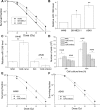Extracellular miR-1246 promotes lung cancer cell proliferation and enhances radioresistance by directly targeting DR5
- PMID: 27129166
- PMCID: PMC5078045
- DOI: 10.18632/oncotarget.9017
Extracellular miR-1246 promotes lung cancer cell proliferation and enhances radioresistance by directly targeting DR5
Abstract
MiRNAs in the circulation have been demonstrated to be a type of signaling molecule involved in intercellular communication but little is known about their role in regulating radiosensitivity. This study aims to investigate the effects of extracellular miRNAs induced by ionizing radiation (IR) on cell proliferation and radiosensitivity. The miRNAs in the conditioned medium (CM) from irradiated and non-irradiated A549 lung cancer cells were compared using a microarray assay and the profiles of 21 miRNAs up and down-regulated by radiation were confirmed by qRT-PCR. One of these miRNAs, miR-1246, was especially abundant outside the cells and had a much higher level compared with that inside of cells. The expressions of miR-1246 in both A549 and H446 cells increased along with irradiation dose and the time post-irradiation. By labeling exosomes and miR-1246 with different fluorescence dyes, it was found that the extracellular miR-1246 could shuttle from its donor cells to other recipient cells by a non-exosome associated pathway. Moreover, the treatments of cells with miR-1246 mimic or its antisense inhibitor showed that the extracellular miR-1246 could enhance the proliferation and radioresistance of lung cancer cells. A luciferase reporter-gene transfer experiment demonstrated that the death receptor 5 (DR5) was the direct target of miR-1246, and the kinetics of DR5 expression was opposite to that of miR-1246 in the irradiated cells. Our results show that the oncogene-like extracellular miR-1246 could act as a signaling messenger between irradiated and non-irradiated cells, more importantly, it contributes to cell radioresistance by directly suppressing the DR5 gene.
Keywords: DR5 gene; bystander effect; exosomes; extracellular mR-1246; radioresistance.
Conflict of interest statement
The authors declare that there are no conflicts of interest in work described manuscript.
Figures







Similar articles
-
Exosome-packaged miR-1246 contributes to bystander DNA damage by targeting LIG4.Br J Cancer. 2018 Aug;119(4):492-502. doi: 10.1038/s41416-018-0192-9. Epub 2018 Jul 24. Br J Cancer. 2018. PMID: 30038324 Free PMC article.
-
Radiation-induced miR-208a increases the proliferation and radioresistance by targeting p21 in human lung cancer cells.J Exp Clin Cancer Res. 2016 Jan 12;35:7. doi: 10.1186/s13046-016-0285-3. J Exp Clin Cancer Res. 2016. PMID: 26754670 Free PMC article.
-
Exosome-mediated microRNA transfer plays a role in radiation-induced bystander effect.RNA Biol. 2015;12(12):1355-63. doi: 10.1080/15476286.2015.1100795. RNA Biol. 2015. PMID: 26488306 Free PMC article.
-
microRNAs: Potential glioblastoma radiosensitizer by targeting radiation-related molecular pathways.Mutat Res. 2019 Nov;816-818:111679. doi: 10.1016/j.mrfmmm.2019.111679. Epub 2019 Oct 21. Mutat Res. 2019. PMID: 31715522 Review.
-
The Influence of Ionizing Radiation on Exosome Composition, Secretion and Intercellular Communication.Protein Pept Lett. 2016;23(7):656-63. doi: 10.2174/0929866523666160427105138. Protein Pept Lett. 2016. PMID: 27117741 Free PMC article. Review.
Cited by
-
Exosome-packaged miR-1246 contributes to bystander DNA damage by targeting LIG4.Br J Cancer. 2018 Aug;119(4):492-502. doi: 10.1038/s41416-018-0192-9. Epub 2018 Jul 24. Br J Cancer. 2018. PMID: 30038324 Free PMC article.
-
Emerging role of exosomes in cancer therapy: progress and challenges.Mol Cancer. 2025 Jan 13;24(1):13. doi: 10.1186/s12943-024-02215-4. Mol Cancer. 2025. PMID: 39806451 Free PMC article. Review.
-
Tissue-specific and exosomal miRNAs in lung cancer radiotherapy: from regulatory mechanisms to clinical implications.Cancer Manag Res. 2019 May 13;11:4413-4424. doi: 10.2147/CMAR.S198966. eCollection 2019. Cancer Manag Res. 2019. PMID: 31191004 Free PMC article. Review.
-
Role of non-coding RNAs and RNA modifiers in cancer therapy resistance.Mol Cancer. 2020 Mar 2;19(1):47. doi: 10.1186/s12943-020-01171-z. Mol Cancer. 2020. PMID: 32122355 Free PMC article. Review.
-
Aberrant miR-1246 expression promotes radioresistance in non-small cell lung cancer: a potential prognostic biomarker and radiotherapy sensitization target.Am J Cancer Res. 2020 Jan 1;10(1):314-335. eCollection 2020. Am J Cancer Res. 2020. Retraction in: Am J Cancer Res. 2020 Aug 01;10(8):2689. PMID: 32064170 Free PMC article. Retracted.
References
MeSH terms
Substances
LinkOut - more resources
Full Text Sources
Other Literature Sources
Medical

